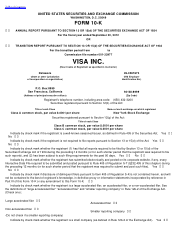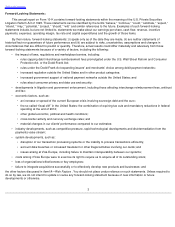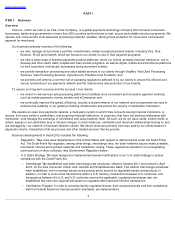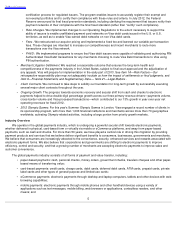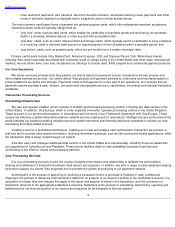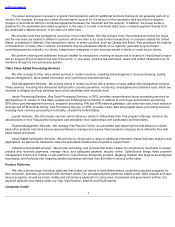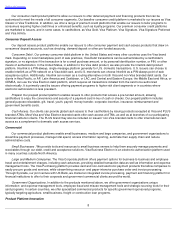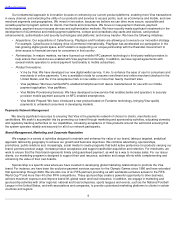Visa 2012 Annual Report Download - page 8
Download and view the complete annual report
Please find page 8 of the 2012 Visa annual report below. You can navigate through the pages in the report by either clicking on the pages listed below, or by using the keyword search tool below to find specific information within the annual report.
Table of Contents
The most common card-based forms of payment are general purpose cards, which offer widespread merchant acceptance.
General purpose cards are typically categorized as:
Primary card brands include Visa, MasterCard, American Express, JCB, and Discover/Diners Club. While these brands,
including Visa, were historically associated with consumer credit or charge cards in the United States and other major international
markets, we and others have, over time, broadened our offerings to include debit, ATM, prepaid and commercial payment products.
Our Core Operations
We derive revenues primarily from fees paid by our clients based on payments volume, transactions that we process and
other related services we provide. Our clients deliver Visa products and payment services to consumers and merchants based on
product platforms we define and manage. Payments network management is a core part of our operations, as it ensures that our
payments system provides a safe, efficient, consistent and interoperable service to cardholders, merchants and financial institutions
worldwide.
Transaction Processing Services
Processing Infrastructure
We own and operate VisaNet, which consists of multiple synchronized processing centers, including two data centers in the
United States. In addition, Visa Europe, which is under separate ownership, operates processing centers in the United Kingdom.
These are part of our synchronized system, in accordance with the terms of our Framework Agreement with Visa Europe. These
centers are linked by a global telecommunications network and are engineered for redundancy. Intelligent access points around the
world complete our global processing infrastructure and enable merchants and financial institutions worldwide to access our core
processing and value-added services.
VisaNet is built on a centralized architecture, enabling us to view and analyze each authorization transaction we process in
real time and to provide value-
added information, including information products, such as risk scoring and loyalty applications, while
the transaction data is being routed through our system.
Visa also owns and manages additional data centers in the United States and internationally, including those we added with
our acquisitions of CyberSource and PlaySpan. These secure facilities allow for high availability transaction services and
connectivity to the Internet, clients and processing partners.
Core Processing Services
Our core processing services involve the routing of payment information and related data to facilitate the authorization,
clearing and settlement of transactions between Visa issuers and acquirers. In addition, we offer a range of value-
added processing
services to support our clients' Visa programs and to promote the growth and security of our payments network.
Authorization is the process of approving or declining a transaction before a purchase is finalized or cash is disbursed.
Clearing is the process of delivering final transaction data from an acquirer to an issuer for posting to the cardholder's account, the
calculation of certain fees and charges that apply to the issuer and acquirer involved in the transaction, and the conversion of
transaction amounts to the appropriate settlement currencies. Settlement is the process of calculating, determining, reporting and
transferring the net financial position of our issuers and acquirers for all transactions that are cleared.
6
• other electronic payments: wire transfers, electronic benefits transfers, automated clearing house payments and other
forms of electronic payment not typically tied to a payment card or similar access device.
• “pay now” cards, such as debit cards, which enable the cardholder to purchase goods and services by an automatic
debit to a checking, demand deposit or other account with accessible funds;
• “pay later”
cards, such as credit, deferred debit and charge cards, which typically permit a cardholder to carry a balance
in a revolving credit or deferred debit account or require payment of the full balance within a specified period; and
• “pay before” cards, such as prepaid cards, which are pre-
funded up to a certain monetary value.


